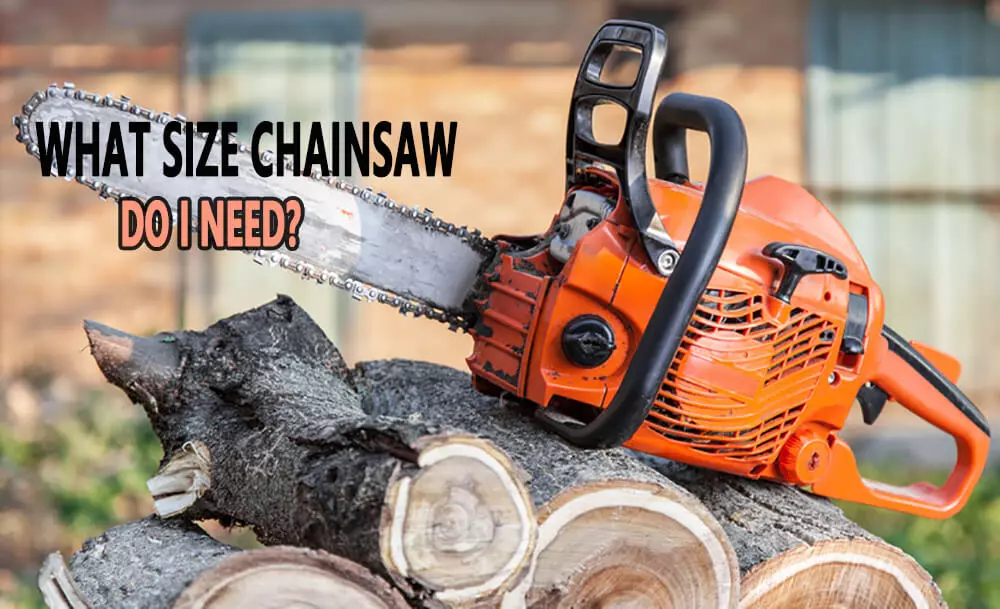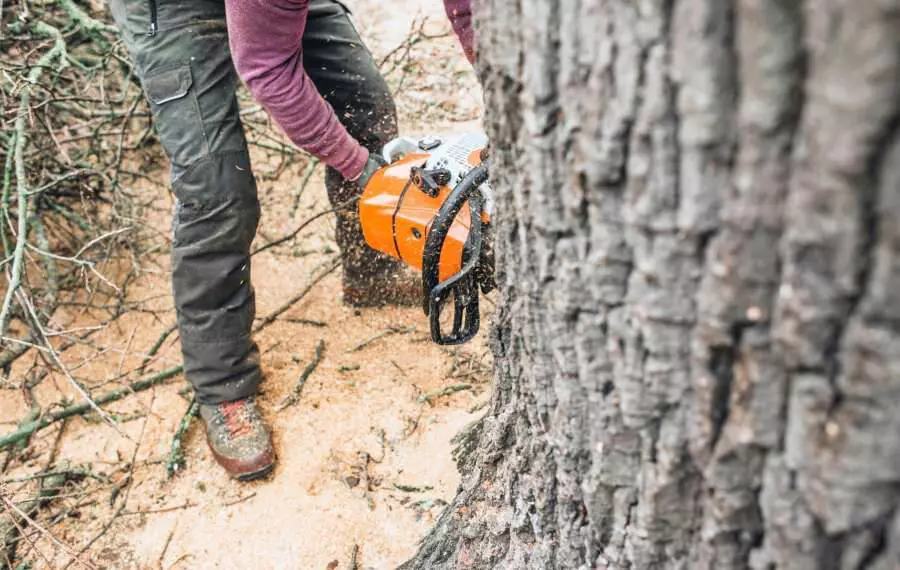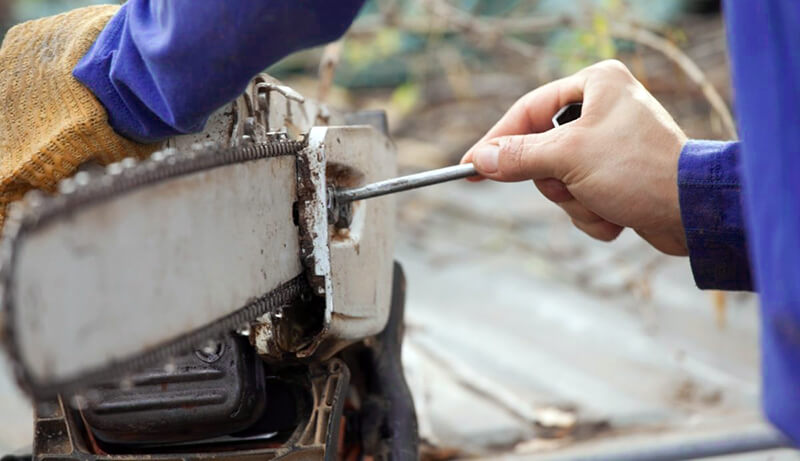11Dec 2024
table of contents

Envision yourself in the backyard, tasked with removing trees toppled by a storm. You grab your reliable chainsaw, only to discover it's too small for large trunks or too cumbersome for precision work. This predicament highlights the critical need to select proper chainsaw size, which is vital for both your safety and task's efficiency.
Chainsaw that's too small may overheat or become overloaded, while too large one can be awkward and unsafe. This article will help you select ideal chainsaw size tailored to your needs. BISON will cover key considerations, such as the wood type you'll be cutting and how frequently you'll use chainsaw. By the conclusion, you'll be equipped to choose wisely, optimizing chainsaw's performance for your specific tasks. Continue reading to discover how to match chainsaw to your task and enhance efficiency.
Two crucial aspects to consider when choosing your chainsaw size are the guide bar length and engine power. Engine capacity, typically given in cc or hp, dictates the chainsaw's cutting efficiency with tough materials. More power generally means better performance on demanding jobs. However, bigger isn't always better—too large an engine can be unwieldy and risky. It's essential to align engine size with your needs for both safety and efficiency.
Guide bar length This directly affects a chainsaw's ability to handle different diameters and types of wood. Typically, guide bars fall into three categories:
Short guide bars (12-14 inches): Ideal for light duties such as pruning and trimming small branches. Good for beginners and ensures better control.
Medium guide bars (16-20 inches): Perfect for general use, like chopping firewood or handling medium sized trees. Highly preferred by homeowners and property managers.
Long guide bars (22 inches and up): Designed for heavy-duty tasks, such as felling large trees or handling thick wood. Better suited for experienced users due to increased power and reach.
Choosing the right chain saw size depends on several key factors that go beyond just looking at the blade length. Careful consideration of these factors will ensure you choose the saw that performs best, offers increased safety, and meets your individual needs.
When choosing the right chainsaw size, consider these key factors:
The characteristics of wood influences chainsaw selection.
Hardwood vs softwood: Tougher hardwoods such as oak and maple need stronger chainsaws, while softer woods like pine cut more easily.
Green vs dry wood: Moist, green wood demands a more robust chainsaw than dry wood. Consider this when making your selection.
Size of tree/log: For thicker trees and logs, use a chainsaw with guide bar long enough to match the wood's diameter. Typically, choose a guide bar that extends 2 inches beyond the wood's diameter for cutting.
Beginner vs experienced user: Beginners should choose a smaller, more manageable chainsaw for safety and control. Experienced users can easily handle larger, more powerful models.
Occasional use: For tasks that are done occasionally, a smaller, lightweight saw is sufficient and easier to manage.
Frequent use: Professionals and frequent users can benefit from larger, more durable models designed for heavy duty work.
Avoid using heavy or unbalanced chainsaws to prevent fatigue and reduce injury risk. Pay attention to chainsaw's weight, handle configuration and overall ergonomics. Select a chainsaw that feels comfortably and balanced in your hand for safe, effective use.
Different types of chains are designed for specific cutting tasks, ensure the chain type matches the wood you're cutting and your chainsaw model.
Look for features such as anti-vibration technology, tool-free chain tensioning and automatic oilers that can enhance comfort, convenience and safety.
Chainsaws range in price from affordable home models to professional-grade saws. Create a budget and choose the saw that best suits your needs and intended use.
By thoughtfully assessing these factors, you'll pick a chainsaw that meets your needs and enhances cutting performance.
Choosing the right chainsaw requires understanding the range of tasks and matching them to the appropriate chainsaw size. Here is a breakdown:
These portable chainsaws are ideal for homeowners. They're user friendly and perfect for activities like:
Pruning and trimming: A 10-14 inch guide bar is perfect for light jobs like cutting small branches or shaping hedges, providing great agility and control.
Home garden tasks: A chainsaw with a 16-18 inch guide bar excels at bigger jobs, easily managing small trees while still being easy to operate.
These medium chainsaws blend robust performance with agility, suitable for landowners, farmers and those with intensive cutting requirements:
Cutting firewood: 18-20 inch chainsaws are more versatile and commonly used for cutting firewood. It provides the power needed while being easy to use for everyday use.
Pruning medium trees on the farm: 16-20 inch blades are perfect for farm tasks, balancing power and precision for medium-sized trees.
These powerful saws are designed for heavy duty applications and require experience and professional training to operate safely:
Forestry work and professional logging: For heavy duty tasks such as felling large trees, chainsaws with blades longer than 20 inches are required. These models are designed for high efficiency and power and are suitable for professional forestry work.

Chain saws have two types of power saw chains: gasoline chainsaws and electric chainsaws. Blade length matters, but so does your fuel choice. Each option has upsides and downsides. Choosing wisely means matching the saw to the task.
Pros:
Strong power and performance for tough tasks.
Portability, not dependent on an electrical outlet.
Cons:
Heavier and noisier.
Requires regular maintenance and fuel mixing.
Size:
Small gasoline chainsaw (14-16 inch blade): Perfect for light cutting tasks, like pruning and trimming.
Medium gasoline chainsaw (16-20 inch blade): Suitable for regular maintenance and firewood chopping.
Large gasoline chainsaw (20+ inch blade): Best for professional use such as felling large trees.
Pros:
Quieter operation and easier to start.
Low maintenance and environmentally friendly.
Cons:
Limited power compared to gas models.
Reliant on battery life or power cord.
Size:
Small electric chainsaw (10 - 14 inch blade): Perfect for light duties like pruning or garden upkeep.
Medium electric chainsaw (14 - 18 inch blade): Great for moderate tasks and occasional firewood cutting.
By evaluating pros and cons of two chainsaws and considering their various sizes, we can confidently choose the perfect chainsaw tailored to your unique needs and cutting jobs.
Know proper maintenance is crucial for chainsaw's smooth operation, optimal performance and longevity. Some key maintenance practices include:
Sharpening the chain: Keep your chain sharp to cut efficiently and safely. Sharpen it yourself with a file or use professional sharpening services to reduce kickback risk and saw stress.
Cleaning the chain saw: Clean sawdust and debris from saw body and guide bar after each use. This prevents buildup from interfering with saw's operation.
Maintaining proper oil levels: Ensure guide bar and chain oil reservoirs are filled with right oil to minimize friction and prevent overheating. Check the oil level regularly during operation.

Choosing a proper chainsaw is crucial for both efficiency and user safety. Consider everything from blade length to wood type and your experience level. If there's no one-size-fits-all chainsaw, consult a professional or visit a reputable dealer like BISON for tailored advice to find the perfect saw for your needs.
With this knowledge, confidently pick the ideal chainsaw for any cutting job. So go ahead and trim those branches, fell those trees and clear that firewood pile. What are you waiting for? Find your perfect chainsaw today!
inquiry form here
BISON BLOG, All the latest news and views from Bison Machinery.